
The Diocese of Borongan in the central Philippines is in the thick of preparations for activities to mark the 500th anniversary of the arrival of Christianity in the country this year.
On Homonhon island in the town of Guiuan, the parish of Saint John the Baptist, will be planting 500 trees in the village of Pagbabangnan.
A song-writing competition has also been launched as part of the series of activities that will highlight the celebrations in Waray-Waray language.
Earlier, a book on Polish Franciscan missionary priest Cantius Kobak, known as the “historian of Samar,” was also launched.
Residents, visitors, and photographers who have visited the island of Homonhon will also be having a photo exhibit with the theme: “Homonhon Nature and Destruction,” highlighting the various species of birds and the beauty of the island amid the threat of mining operations.
Bishop Crispin Varquez of Borongan expressed his wish to commemorate the anniversary, especially in the parish of St. John the Baptist on Homonhon where the Portuguese explorer, Ferdinand Magellan, first set foot in a journey that led to the evangelization of the Philippines.
“In our participation, we also proclaim, filled with strong faith, the goodness of our God, the goodness of our people, and our liberating Catholic faith,” said the bishop.
On March 16, 1521, Magellan landed on Homonhon after sailing from the Marianas Islands. He and his men stayed on the island for eight days to rest and replenish supplies.
Through an interpreter, Magellan told the natives that the expedition was sent by the king of Spain to “spread the Catholic faith” and convert people to the “true religion.”
Some historical accounts indicated that on March 19, the Spaniards celebrated Mass and planted a cross near the shores of Homonhon.
The Philippine government, however, declared another island, Limasawa, as the site of the first Mass on March 31.
Source: Licas Philippines
0 Comments